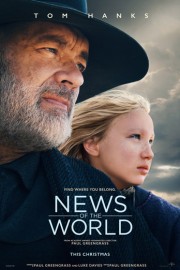News of the World
Earlier this year, I finally watched the “Lonesome Dove” TV miniseries that I had borrowed from my father-in-law a few years ago; furlough finally gave me the time to dive into them. I couldn’t help but think of the elegant, elegiac storytelling in Larry McMurtry’s narratives while watching “News of the World.” There’s something simple but complex in this story that would fit right in to McMurtry’s world (also, a cameo from Ray McKinnon helped connect the two), and co-writer/director Paul Greengrass’s adaptation of Paulette Jiles’s novel captures a moment in post-Civil War America where soldiers are trying to find their place now that the war has stopped. Joining him on screen in Tom Hanks, and the two seem to have an innate connection that just works, at this point in their careers between this and “Captain Phillips.”
Hanks stars as Captain Jefferson Kyle Kidd, who has become a storyteller after the Civil War. He goes around, from town to town, picking up newspapers, and reading people the news. Even though the stories he is reading are true, they fill a void for stories in these people’s lives that have humdrum lives, working and spending their lives in one place; they also help people who cannot read for themselves. One day, he comes across a wagon that was destroyed, and a hanging body, as well as a young girl who only speaks Kiowa, a Native American language. He does manage to find out that her name is Johanna (Helena Zengel), and that her parents were killed by Indians, and her nearest relatives are 400 miles away. He has a choice- he can stay and wait for someone who can reunite her with her relatives, or he can take her herself. It’s pretty obvious which one will move the story along.
There’s not really anything original in “News of the World,” but that’s not a bad thing- this is as meat-and-potatoes a Western as Westerns get, and I really enjoyed it for that reason. Greengrass seems to have studied the archetypes of the Western genre in crafting the screenplay with Luke Davies, and his direction is straight-forward and clear-eyed. He and cinematographer Dariusz Wolski have created a visual language that is modern but also feels like a throwback to Westerns past, and James Newton Howard’s score is a great evocation of the genre. This is one of those films where you watch it, and realize how much the Western genre is capable of, and the void left in American genre cinema when we don’t get one in a while.
The types of roles Hanks has been taking on as he’s gotten older are fascinating and enlightening. He’s not just leaning into his everyman charisma, but every once in a while, working with filmmakers (like the Wachowski Sisters, Tom Tykwer and Greengrass) who are interested in pulling something more out of him. Captain Kidd is a relatively straightforward character, but what his arc here is leaves some choices for him to make. When he’s taking Johanna to her relatives, he is stopped and asked to read for a specific pamphlet, to apply his trade for a specific person’s interests; instead, he reads about workers suffering, which isn’t quite the message they wanted to have put out there. And when he does make his way to Johanna’s family, it opens the door to a fundamental question about whether it’s better for someone to be with family, or in a different situation that might be better. The way the film ends is the only way it could end, and it makes us wonder whether, like McMurtry, maybe Greengrass and Hanks could revisit these characters down the road, to see how they’ve grown with one another. That’s probably wishful thinking, but the idea that life could ever be the same after a tragedy is, as well, something this film states quite clearly by the time it ends.










